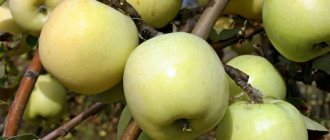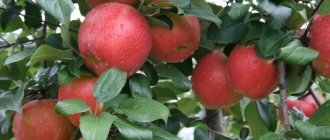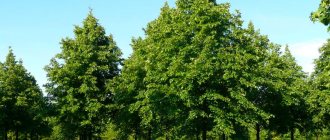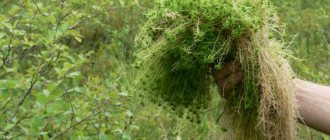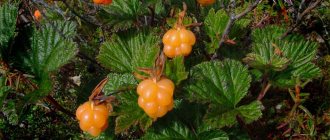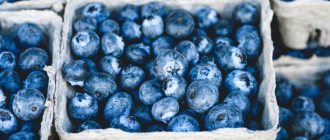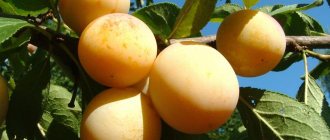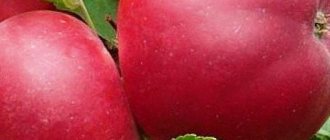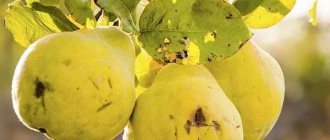Description and characteristics
The Honey Crisp apple tree is a winter variety that is harvested late, even by winter standards. It has a lot of positive properties for which gardeners and gardeners value it. Among them I would like to note:
- early onset of fruiting;
- planting resistance to low temperatures;
- amazing taste and appearance of the fruit;
- long shelf life of fruits without loss of quality;
- resistance to fungal diseases.
There are also some disadvantages. During storage, it is necessary to provide only the correct temperature and humidity conditions for Honey apples. Otherwise, they may show subcutaneous spotting.
Tree height
The height of the apple tree is average: no more than 4 meters. But Honey is also grown on dwarf or semi-dwarf rootstocks to make it more convenient to care for the apple tree. Then the height reaches about 3 meters.
Honey Crisp apple tree.
Crown width
The crown of an adult apple tree is broadly oval in shape; shoots form quickly. A young planting usually has a crown in the shape of a narrow pyramid. The growth rate is quite high.
Productivity of the variety
From an ordinary mature tree you can collect up to 10 kg of large apples weighing up to 250 grams.
Tasting assessment
The taste of the fruit is sweet, even honey-like, the sourness is light and barely noticeable. The skin is shiny and dense, yellow-green with a reddish blush. Organoleptic rating – 4.8 points. The light spicy varietal aroma is also noteworthy.
Winter hardiness
The Honey Crisp apple tree is considered frost-resistant. It tolerates temperatures down to -35°C, but not always. If the variety is still too young and has suffered from diseases, then resistance may decrease.
Possible decreased immunity due to excessive fruiting. If an apple tree has been overloaded with fruits during the season, then its level of resistance decreases.
Disease resistance
Scab is the most dangerous of fungal diseases; it practically does not occur on apple trees. Powdery mildew is also a rare guest on the plant. For prevention purposes, it is better to carry out preventive spraying in the spring to protect the apple tree. Still, it is better to be more vigilant in this matter.
This is what scab looks like on the leaves of a Honey Crisp apple tree.
Powdery mildew appears as a dense whitish coating on all parts of the fruit crop. And scab looks like oily dark spots. In the spring, for prevention, spraying with copper-containing products is carried out. Among the chemical preparations you can use Thiovit, Rayok, Fundazol, Strobi. These drugs can be used for prevention and treatment.
Description of the Honey Crisp apple tree
Honey (in other versions - Honey, which is a literal transcription of the English honey) Crisp is an American variety bred in Minnesota in 1974. The basis for its creation was the Honey Gold and Makaun varieties, and the excellent taste characteristics of the first were complemented by the winter hardiness of the second, which made it possible to grow the apple tree, beloved by many Americans, in more northern climatic conditions.
People who speak English can well imagine the main characteristic of the variety - crispy pulp with a honey aroma (honey crisp literally translates as “crisp honey” or, more simply, “honey crunch”).
In the 90s of the last century, Honey Crisp conquered the entire territory of the United States, took root well in cold Canada, from there it was brought to Europe and finally appeared in Russia and other CIS countries. In particular, today it is successfully grown in the Central and other regions of the Russian Federation, Ukraine, Belarus and Moldova.
Did you know? Macintosh is another well-known American apple variety in Russia, which they say was very fond of Jeff Raskin, who, as you know, is the author of the Macintosh or Mac line of personal computers produced by Apple Corporation. It is interesting that Steve Jobs at one time had to buy the rights to use this “Apple” name, since Raskin refused to give it away for free.
This apple tree can also be planted in areas with colder climates, but the taste characteristics of the fruits in this case are somewhat different from those grown to the south: they become more sour, which, in general, is not so much a disadvantage as something of a new feature. variety modifications.
The Honey Crisp tree is notable for its not very high growth vigor and average size, although they directly depend on the rootstock on which the variety is grafted: when the manufacturer uses a medium-sized rootstock, the height of the tree reaches 3–4 m; on a dwarf seed rootstock, the apple tree grows only up to 2 m.
The crown of the tree stretches as it grows, changing its shape from round to oval. In the first years, the shoots grow quite quickly and evenly, but starting from the 6th year, the intensity of their growth decreases. The branches are of medium thickness and grow mainly at an acute angle to the trunk.
The fruits are formed 3-4 pieces on one inflorescence, which, given their large size and short stalk, makes for a high probability of rapid fall.
Main characteristics of the fruit:
| Form | Round-conical, always symmetrical with uniform lighting. |
| Dimensions | Equally large, average weight - 250 g. |
| Peel coloring | Yellow-green, sometimes with a blurred crimson blush and subcutaneous spots of varying degrees of intensity. |
| Peel structure | Smooth, thin, almost without shine |
| Pulp | Creamy, very juicy, but not watery, bites off with a pronounced crunch. |
| Taste characteristics | The taste is honey with sourness, rich fruity aroma. |
| Tasting rating on a five-point scale | From 4.8 to 5. |
| Productivity | High. Already at the age of 6, from one tree you can remove from 6 to 9 kg of fruit, then this figure increases. |
Planting and growing
It is very important to know the basic rules for planting and caring for an apple tree. If a young apple tree is planted incorrectly, it may develop poorly, not producing fruit, but increasing green mass. The variety is planted like other fruit trees.
Landing dates
Planting can be done in autumn or spring. At the beginning of the year, it is necessary to plant before the buds begin to swell, and in the fall after the sap flow has slowed down. But at the same time, seedlings with closed roots can be planted in the summer, although it is not advisable.
Technology
The technology for planting an apple tree of the Honey Crisp variety is similar to any other. Step by step it is necessary:
- Prepare the planting hole in advance by adding fertilizer to it. The size of the hole depends on the root, but its depth is at least 50 cm and its diameter is 80 cm;
- Place the seedling in the center, straighten the roots and sprinkle with soil;
- place a peg nearby that will serve as a support;
- Honey seedling is watered;
- The tree trunk circle is mulched.
A clear example of proper planting of an apple tree.
The variety does not like it when the grafting site is covered with soil. It is necessary to ensure that the root neck is 3-4 cm above the ground.
Features of cultivation
Among the growing features, there are no complex manipulations that would not be carried out with other fruit crops. Honey Crisp responds very gratefully to fertilizer. But in the first year after planting there is no need for them.
The further feeding procedure is standard:
- in the spring you will need to apply fertilizers with nitrogen;
- Before flowering begins, complex fertilizer is necessary;
- at the end of summer, fertilizing with phosphorus and potassium is needed;
- humus should be added to the tree trunk circle in the fall;
- During the season, you can apply mineral fertilizers to the leaves.
A sufficient amount of nutrition will help the apple tree to fully develop, maintain immunity and produce large fruits.
Pruning and crown formation
An important condition for care will be formative pruning, which can easily be combined with sanitary pruning. It is carried out according to the following scheme:
- the central conductor is cut off so that lateral shoots can grow;
- the entire increase is reduced by a third;
- the upper branches, which grow parallel to the central one, are cut into a ring;
- shoots that grow inside the crown and interfere with others must also be removed.
Apple tree pruning scheme depending on growth period.
The crown can be formed either rounded or tiered-sparse. But this must be done constantly to make caring for the apple tree more convenient.
Pollinator varieties
The Honey Crisp apple tree variety needs pollinators growing nearby. If there are no such people, then there will be practically no ovaries on the tree. Accordingly, this will have an extremely negative impact on fruiting.
The best varieties for pollination are:
- Everest;
- Idared;
- Granddaughter;
- Gloucester;
- Askold.
But there may be others that bloom at the same time as the Honey Crisp variety. The optimal distance is considered to be no more than 50 meters.
Features of growing Honey Crisp
Landing
Key Features
- For planting this variety, choose sunny areas with good ventilation.
- Any soil is suitable for Honey, as long as it is not very acidic. Acidity of pH 7 or more can kill a tree without even allowing it to take root.
- Planting holes should be prepared in advance, ideally in the fall. But if you plant apple trees in the spring, then digging them out in 3-4 weeks will be enough. Part of the soil is taken out, mixed with humus, ash or other fertilizers and poured back. After this, they are left in the open air.
- The optimal size of the holes is 80 centimeters deep and approximately 1 meter in diameter.
- Drainage is poured onto the bottom immediately before planting, in a layer of 10-15 centimeters. You can use vermiculite, broken brick, nut shells or gravel.
- Before planting, seedlings can be dipped in water for a couple of hours to revive them. It is better to immediately cut off dried or damaged roots with pruning shears.
- The root collar should protrude no more than 2-3 centimeters above the soil surface, otherwise it will slow down the first fruiting.
- On the north side it would not hurt to dig stakes for tying up young trees. It is not necessary to take them out before 4-5 years of age.
- The root system is sprinkled with earth and compacted tightly, watered with 30-40 liters of water.
You need to buy seedlings only in special nurseries, where you can be provided with all the information and accompanying documentation for them. Now there are a lot of scammers on the market who offer plants of completely different varieties to inexperienced gardeners, passing them off as elite, so you need to be extremely careful.
Disembarkation dates
It all depends on the type of root system of the planting material used. If you have a seedling in a pot from which you do not need to remove it, then you can plant it at any time throughout the growing season. If the rhizome is open, then it is better to start planting in the spring before the buds open or in the fall, immediately after the end of leaf fall. In the second case, the survival rate of trees is much higher.
Pruning: simple crown formation
In the year of planting, it is not customary to prune Honey Crisp or add fertilizer to the soil. Therefore, the first pruning will take place on the second. You will need to shorten the main shoot by a third. The lateral skeletal branches are made even shorter, according to how they grow in tiers.
In the future, all these actions must be repeated annually, adding to the plan the elimination of branches directed vertically upward (tops) or inside the crown, seriously thickening it. With regular sanitary pruning, you will have to cut off all diseased, dry, rotten or otherwise damaged branches.
Tree care
Loosening the soil, watering: proper agricultural technology
Apple trees do not need to loosen the soil and they do not even need regular watering. However, if you pull out weeds, remove grass, shoots of various plants, and root shoots, then this is only a plus. There is definitely no need to water forcibly, but if the weather is dry, you can add moisture once every ten days.
Pollinator varieties
- Gloucester.
- Delicious golden.
- Idared.
- Granddaughter of Askold.
- Everest.
Reproduction
- Growing from seeds (rare).
- Grafting with cuttings or buds.
- Layers (clones).
Diseases and pests
- Powdery mildew.
- Black cancer.
- Scab.
- Green aphid.
- Flower beetle
- Leaf roller.
- Codling moth.
Care
Although caring for the Honey Crisp apple tree is quite simple, it is necessary to clarify some nuances. Proper care will help the apple tree grow and develop fully. Depending on the time of year, there are some nuances to consider.
Features of spring care
In spring, apple tree care should begin with a visual inspection. This is especially true for those regions where there are frosts below 35°C. Frost holes and cracks may appear on the bark, which must be thoroughly cleaned and treated with garden varnish.
Spraying an apple tree with a prophylactic agent.
The next activities that will need to be carried out in the spring will be spraying. There are several of them:
- from pests that feed on young buds, buds and shoots;
- preventive treatment against diseases;
- watering;
- fertilizing with nitrogen substances.
All these procedures are carried out before the buds bloom, or according to the green cone.
Summer care
In summer, monitoring of the plant’s appearance continues. This is important in order to promptly detect the appearance of a pest. After flowering, you will need to carry out another spraying to protect the flowers from harmful insects.
Also, watering will be required in the summer season. It is especially important in the process of fruit filling. Along with watering, you can also apply fertilizers. Potassium-phosphorus fertilizers are applied at the root.
Another important procedure is rationing the amount of harvest. A peculiarity of the fruiting of the Honey Crisp variety is that with excess moisture the fruits become deformed and become smaller. An excess harvest one year may result in virtually no harvest the next year. It is best to remove excess ovaries.
Autumn care
The ripening of Honey Crisp fruits is uneven, and the variety is prone to shedding. Therefore, it is necessary to monitor the maturation process. It is better to always keep the tree trunk area clean so that the carrion remains clean.
After the harvest is completed, you need to add fertilizer to maintain the vitality of the apple tree. This will require potassium and phosphorus. It is also necessary to carry out another pest control treatment.
Preparing for winter
If the autumn is very dry, then it is necessary to water.
Whitewashing the trunk of a Honey Crisp apple tree.
When the first frosts arrive, care for the tree trunk circle will be required. It needs to be cleaned, dug up, added organic matter and mulched. The trunk must be whitened and insulated.
Description of the variety with photo
Honey Crisp is an excellent winter variety. Begins to bear fruit in the fourth year. A young six-year-old tree produces up to 9 kg of apples, an adult - 23. The flowering period is average, the duration is long. Ripening period is October. The trees are low-growing with a mixed type of fruiting, pollinated by the following varieties: Everest, Goden Delicious, Idared, Askold, Rudy Mountaineer, Vnuchka.
A young tree has a narrow, oval crown; after it enters the period of stable fruiting, it becomes oval, wide, with strong short branches, not thickened. The angle between the skeletal branches and the central conductor is acute. The height of mature trees is 3 meters, they grow quickly.
The thickness of the shoots is average, the color is yellowish-brown. They are straight with pubescence and long, rounded lentils. Medium-sized buds are tightly attached to the shoots and are colored brown. The green leaves are small, shiny with a characteristic bluish tint. The shape of the plate is ovoid with a leathery, pubescent surface, a sharp downward tip and wavy, serrated edges.
Fruit
The fruits are large, one-dimensional, weigh 220-250 g. The shape is round-conical, elongated, sometimes asymmetrical. The main color is yellow-green, light. The blush is blurry, orange-red with noticeable streaks and spots of dull red color, covering most of the fruit (80%).
The pulp is juicy, creamy-yellow in color, bites with a crunch, and contains a lot of juice. The taste of the fruit deserves a rating of 5 points, it is sweet and sour. The skin is smooth, medium in thickness, slightly shiny, white subcutaneous dots are visible.
The appearance of the fruits is beautiful, they reach technical ripeness in the 20th of September, consumer ripeness in the first ten days of November. Apples keep well in the refrigerator for up to 7 months. Transportation does not affect the presentation.
During storage, infection is possible, affecting subcutaneous spotting. Apples are eaten fresh. The main characteristics are winter hardiness and disease resistance above average. The variety performed well in relation to pathogens of scab and powdery mildew. The variety was bred in Minnesota, which determined its good winter hardiness and can be grown in many Russian regions.
Harvesting and storage
Fruit ripening is quite extended and usually begins in September. Ripe apples are easily removed from the branches, their seeds have a rich brown color.
Not all apples are picked at once. The first to remove are those at the edges of the branches, and then in the middle of the crown and on the lower shoots.
Honey Crisp fruits can be stored for 6-7 months. To preserve them, you need to carefully place them in boxes in layers and cover them with paper. The storage temperature should be around 0°C and the humidity level should be around 90%. It is better to periodically inspect the harvested crop and remove damaged fruits.
Honey Crisp apple harvest.
How to choose seedlings
One- and two-year-old trees are most suitable for planting. You must immediately make a choice on which rootstock to graft. Planting and further care depend on this. An external inspection should make sure that the plant is healthy and has no damage to the crown or roots. The best option is seedlings with a closed root system.
When ordering seedlings from European nurseries, you need to know that there this variety is known as Honeycrunch and is zoned for regions with cool summers.
Diseases and pests
Honey Crisp apples have one peculiarity: when stored, dark spots may appear under the skin of the fruit. They spoil the taste of apples. It is important to spray in the spring to protect the fruits from this disease. To do this, it is necessary to add lime or dolomite flour in the spring, and periodically add potassium after the fruits have formed.
The fruit crop has immunity, and it is quite high. Fungal diseases occur very rarely. But it is still necessary to carry out preventive treatments in the spring. For them, you can use copper preparations or Fundazol.
It is necessary to carry out comprehensive protection against pests throughout the season:
- along the green cone;
- after flowering;
- after harvest.
If pests appear during fruit ripening, they also need to be combated. It is better to use traditional methods. All chemicals penetrate into the fetus and can accumulate there, so their use is undesirable.
Advantages and disadvantages
The main advantages of this variety include:
- Easy care and harvesting due to the compactness of the crown;
- The fruits are of commercial quality and are well stored;
- Excellent taste;
- Apples are transported over fairly long distances without loss;
- During long-term storage, the taste of apples does not change.
Read also: DIY soft toy angel
However, there are also some disadvantages of the Honey Crisp variety. One of them is susceptibility to fungal diseases. Sometimes when storing crops, spotting occurs under the skin.
Although Hani apple trees may develop a slight, sour taste from lack of warmth when planted in regions closer to the north, this variety is considered very good for any garden, with a honey-like flavor. Each plant that appears on the site requires certain care, and these apple trees are no exception. By doing everything according to the rules, you can provide yourself with delicious fruits for a long time.
Most gardeners and summer residents begin planting a garden by planting apple trees, because this is the most common and favorite tree in Russia.
Also, most amateur gardeners believe that this is an unpretentious fruit tree that does not require special care to grow.
But one can argue with this, since without knowing the basic rules of planting, care, pruning, storing crops and other subtleties, it is simply impossible to get good harvests.
Improper planting and care will lead to the fact that the apple tree will not grow well (not grow, but suffer), without fighting diseases and pests, you can be left without a harvest at all. By neglecting the basic rules of pruning, you can grow branches and leaves, not apples.
History of selection
The Honey Crisp variety, a winter-hardy large-fruited hybrid for industrial use, appeared in 1974 as a result of the focused work of North American breeders to improve the characteristics of the Honey Gold apple tree by increasing its winter hardiness. For this purpose, the Makaun variety was used as a pollinator.
From the obtained seeds, specialists from the University of Minnesota grew seedlings that gave rise to a new variety, the name of which, translated into Russian, means “honey crunch.” It is precisely these qualities – honey taste and unusually crispy pulp – that the fruits of the new crop have.
Seedlings of the Honey Crisp variety went on sale in 1991. From that moment on, the culture became widespread in Canada, the USA, Europe, and, more recently, in some regions of the Russian Federation.
Reviews
The shoot formation of the variety is strong, the central conductor is completely overgrown with numerous short and thin branches up to 30 cm long, on which many flower buds are formed. The tree bore its first fruits after planting the following year. The fruits are not just tasty, but amazingly delicious.
The next year, due to good fruit set, they were thinned out to prevent overloading of the young tree.”
In the first year after planting, I received a harvest of approximately 1 kg per tree. The next time it was 5-6 kg per tree, 12 tons per hectare.
The apples are large, the average weight was up to 240 g, individual specimens weighed 300 g. The color of the fruits is bright, the fruits are elongated and round in shape. To me, apples taste very sweet, but everyone likes them.
The fruits are juicy, aromatic, the flesh is crispy and dense. At the end of August you can already pick them from the tree and eat them.
But I harvested the main harvest in early October; the fruits did not fall off and stayed well on the branch (I left one apple in the bud and removed the rest). I treated it twice for diseases: before flowering and after.
I did not notice any damage from scab or powdery mildew. They were stored in the basement until spring, but I treated it for subcutaneous spotting 5 times.”
Last year, the apples ripened already in September and, fearing that they would not be stored well, I treated them with a calcium preparation before storing them. Only about 1% of the fruits were spoiled by subcutaneous spotting. In general, you should try to eat them first in order to avoid this problem.”
In order to avoid problems with storing fruits, he recommended that I treat the trees once every ten days with calcium nitrate in chelated form (liquid) from Kristalon.
The first treatment, when the apple becomes the size of a walnut, in the proportion of 20 g per 10 liters of water and so on until harvest.
And before storing, dip the fruits for 5 minutes in a solution of calcium nitrate (40 grams per 10 liters). I follow his advice every year, no problems.
I’m happy with the variety, the apples are tasty, beautiful, the yield is high, enough for a family of 6 people, we’ll also treat all our friends until spring.”
- Excess of nitrogen fertilizers in fertilizing;
- Rainy years, i.e. high humidity;
- Preservation of fruits on trees;
- Failure to maintain crop storage temperature.
Advantages and disadvantages
The list of advantages of the variety includes:
- High annual yield.
- Excellent transportability of fruits.
- Long shelf life of ripe apples.
- Good winter hardiness.
- Excellent taste and commercial qualities of the fruit.
- Suitability of apples for processing.
- Good resistance of apple trees to fungal infections, powdery mildew and scab.
The Honey Crisp variety has virtually no disadvantages.
The exception is:
- The tendency of ripe apples to fall off (if the harvest is too large), due to the presence of too short stalks, forcing closely spaced fruits to crowd out each other. Fortunately, massive apple shedding does not happen every year.
- Freezing of part of the shoots during severe (below 39 degrees) frosts in apple trees grown in some regions of Siberia, characterized by harsh winters.
- Susceptibility of fruits stored for storage to brown spot.
Storage
- It is best to store Honey Crisp apples in a dry and well-ventilated basement.
- Fruits stored for storage should not be damaged, so only those that have been removed from the branch are suitable for this purpose.
- The best containers for storing apples are shallow wooden boxes. To ensure sufficient air circulation, fruit should be placed in one layer.
- Spoiled apples that cannot be stored can be processed into cider, fruit wine, compotes, juices, and jelly. Their high pectin content makes them suitable for making delicious mousses, jams, marmalades, jams and jellies.
